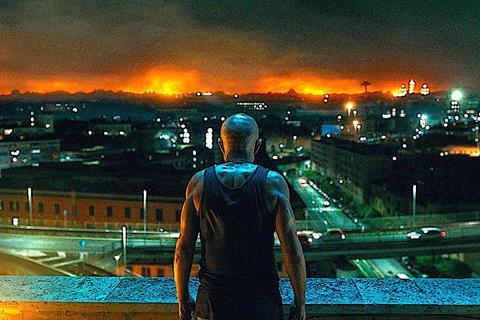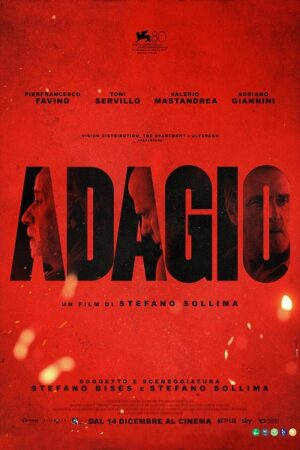“Adagio”, A Sentimental Noir
TORONTO – A master of the crime thriller, filmmaker Stefano Sollima takes the viewer into the deep waters of conflicted fatherhood with “Adagio”. The film explores the multiverse of the father-son relationship, while uncovering the humanity within its tragically flawed characters. Fans of Sollima know him for his gritty crime dramas (film & TV), notably “Sicario”, “Suburra”, Romanzo Criminale and “Gomorrah”, but “Adagio” is perhaps the perfect amalgamation of these works, with a tinge more sentiment than his audience might expect.
Sollima: “From the start I viewed this as a sentimental noir that obviously uses the genre to tell the story of various types of fatherhood…and who above all give themselves a last moment of attempted and clumsy redemption to help a young boy in difficulty. And that is the most memorable part of the story”. The story’s karmic convergences are cued by a haunting visual in the opening credits – a backdrop of massive fires beyond the city’s limits. Rome or part of it at least, is burning.
“Adagio” tells the story of a young boy Manuel (Gianmarco Franchini), fleeing from Carabinieri after refusing to be blackmailed. The tale deliberately unfolds so that the viewer is never completely sure of what’s happening, for what reason and who in fact the characters are – until the approach of the third act. Rome, the setting, is presented as a city in turmoil. The filmmakers give it an aesthetic closer to a run-down American metropolis, similar to the abandoned cities in the video game “Grand Theft Auto”.
From Paolo Carnera’s mood setting Cinematography, to Sollima’s ear for dialogue which his cast imperiously delivers, “Adagio” turns what might have been a typical crime drama into a tragedy of Greek proportions. At the forefront of the drama is Tony Servillo’s character Daytona. He’s Manuel’s father and ex-gangster, suffering through the middle stage of dementia. His condition fluctuates as he witnesses the sins of his past being revisited upon his son. Daytona and Manuel are not the only father-son tandem in the story however, and not the only variety either, as Sollima presents three sons – from good to bad to dead.
“Adagio” ultimately depicts a man’s innate drive to be present for his child, and in a unique way of course, for his son. While Adagio’s characters are criminals with a capital “C”, Sollima insists that even the most unscrupulous among us has a heart. It’s not a reach or forced sentiment, but a central belief that Man, no matter how poor a father, will on some level suffer for it – and in the best of cases attempt to redeem himself. Some critics have labelled the world depicted in “Adagio” as “male toxicity”.
But the term is facile and dim-witted. People are flawed. Ancient storytellers knew this all too well, as they crafted stories about fratricide, patricide, filicide and infanticide. What we learn about ourselves, we tend to learn under duress, through pain and often times through loss. “Adagio” wants to remind the viewer that sometimes the most hardened and unredeemable among us, weren’t born that way, and more importantly, can still help us explore our own psyche.
Massimo Volpe is a filmmaker and freelance writer from Toronto: he writes reviews of Italian films/content on Netflix





